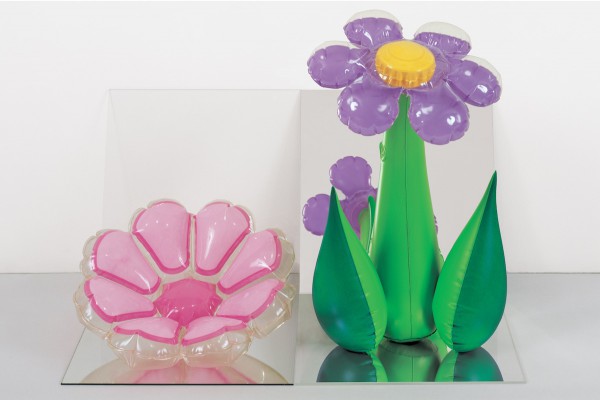
Today, I begin a Koons-o-rama. Once a week for the next little while, the Daily Pic will visit and revisit the almost-perfect Jeff Koons retrospective at the Whitney Museum of American Art in New York. I have huge respect for my fellow critics who feel that Koons is nothing more than a symptom of everything that’s wrong with our art world, and maybe with our culture in general. On my first visit to the show, to shoot a video with my chum Christian Viveros-Fauné, I almost let him convince me that Koons was precisely as bankrupt and shallow a figure as his fiercest critics say. Since then, I’ve spent longer with the Koons show than with almost any display I can remember (with the very notable exception of my week-long inspection of “Las Meninas” at the Prado). On visit after visit, accompanied by any number of deep thinkers on art, I’ve found that Koons has payed major intellectual and visual dividends. His art is simply too productive to be dismissed. I feel as though his haters’ larger, principled – and admirable – objection to certain Koonsian trends in art-world dynamics have blinded them to the details of what Koons has produced.
Today’s Daily Pic, for instance, shows the Whitney digging deep into a little-known prehistory of Koonsiana. It turns out that as far back as 1979, Koons was acquiring and displaying product from some of the stranger corners of popular culture. With “Inflatable Flowers (Short Pink, Tall Purple)”, he makes us want to know how it was that certain late-70s tchotchke producers felt it worth their while to make dumb inflatable flowers with such complex engineering. Koons so appreciates this redundant complexity that he displays his vinyl blossoms on mirrors, just as museums show Fabergé eggs, so that we can take in their details from every side.
Here’s another peculiarity of these works as shown at the Whitney: Koons cares so much about the details of his original vinyl flowers that he has had them laboriously refabricated for this retrospective, making sure that passing time and decaying matter would have no leverage on their appearance. That means that they pass out of the realm of normal Duchampian readymades – objects purchased and presented as art, mostly for the sake of the gesture itself – into a new realm of “re-made readymades”, where the objects themselves matter as much as the action of showing them. (At the risk of once again incurring the wrath of some of the more simpleminded Duchampians, let me say that I consider Marcel’s artisanal remakes of his classic found objects something else altogether than Koons’s; Duchamp’s 1950s urinals are not a recapitulation of the original Dada works, but a piss-taking new riff on what “Fountain” had come to mean.)
On one visit to the Koons retrospective, the room with his vinyl flowers was full of tiny children whose art teacher had told them to draw Koons’s inflatables. This struck me at the time as one of the more colossal misunderstandings that I’d witnessed in a museum: Works of tremendous conceptual complexity were being used to teach kids the most conservative notions of what art should be. But then I was forced to rethink. One of the glories of Koons’s works is that every one of them is a kind of Trojan horse, coming across at first as the simplest, dumbest aesthetic gift, and then turning out to ambush almost every conventional artistic model. I’m afraid to say that some of my Koons-hating colleagues may be a bit like those Koons-sketching kids: They’re stuck on first impressions of the art, and that keeps them from feeling obliged to look deeper. (Collection of Norman and Norah Stone; ©Jeff Koons)
For a full survey of past Daily Pics visit blakegopnik.com/archive